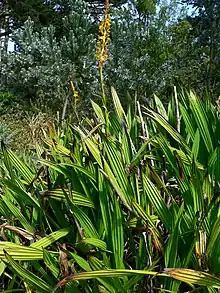Wachendorfia
Wachendorfia, known as red root, is a genus of cormous perennials endemic to Cape Province in South Africa.[1] It was first described as a genus in 1757.[2][3] The genus was named in honour of Evert Jacob van Wachendorff (1703-1758), Dutch professor of botany and chemistry at Utrecht.
- accepted species[1]
- Wachendorfia brachyandra W.F.Barker
- Wachendorfia multiflora (Klatt) J.C.Manning & Goldblatt
- Wachendorfia paniculata Burm.
- Wachendorfia thyrsiflora Burm.
| Wachendorfia | |
|---|---|
 | |
| Wachendorfia thyrsiflora | |
| Scientific classification | |
| Kingdom: | Plantae |
| Clade: | Tracheophytes |
| Clade: | Angiosperms |
| Clade: | Monocots |
| Clade: | Commelinids |
| Order: | Commelinales |
| Family: | Haemodoraceae |
| Subfamily: | Haemodoroideae |
| Genus: | Wachendorfia Burm., 1757, not Loefl. 1758 (Commelinaceae) |
| Synonyms[1] | |
| |
Description
Wachendorfias have basal tufts of long, narrow, pleated leaves and bear erect spikes of starry, yellow flowers in spring and summer.
Their common name stems from the red sap of the corms, used as a dye, and the bright red-orange colour of the roots themselves. Red colour is a feature of many plants in the family Haemodoraceae (Haemo = Blood).[4]
Cultivation
Slightly frost hardy, Wachendorfias thrive outdoors in warm, near frost-free environments as an ornamental plant. Most require moist, well drained soils in a sunny position. Some are ideal for bog gardens.
Gallery
| Wikimedia Commons has media related to Wachendorfia. |
 Wachendorfia thyrsiflora
Wachendorfia thyrsiflora Wachendorfia brachyandra
Wachendorfia brachyandra Wachendorfia thyrsiflora seeds
Wachendorfia thyrsiflora seeds
References
- Kew World Checklist of Selected Plant Families
- Burman, J. 1757. Wachendorfia 2
- Tropicos, Wachendorfia J. Burman
- Gardeners Guide to Plants & Flowers, Readers' Digest, Sydney, NSW, Australia, 1997
- Flora, The Gardeners Bible, ABC Publishing, Ultimo, NSW, Australia, 2005
